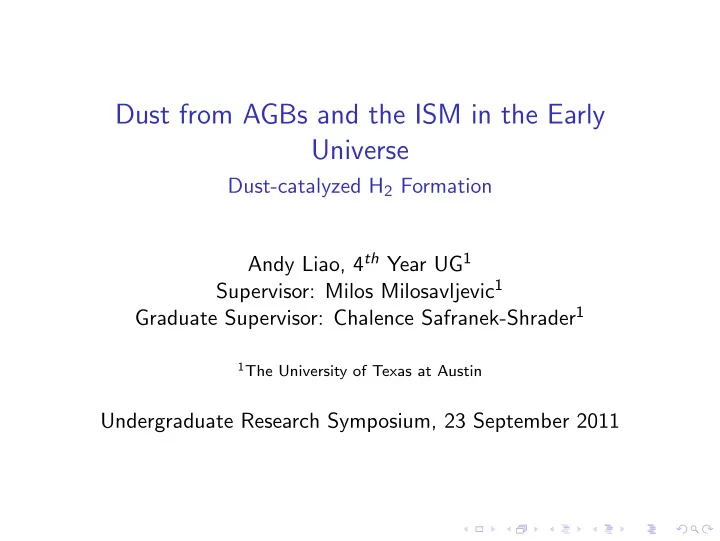

Dust from AGBs and the ISM in the Early Universe Dust-catalyzed H 2 Formation Andy Liao, 4 th Year UG 1 Supervisor: Milos Milosavljevic 1 Graduate Supervisor: Chalence Safranek-Shrader 1 1 The University of Texas at Austin Undergraduate Research Symposium, 23 September 2011
The galactic ISM Wolfire, M.G. (2010) The phase structure of the ISM in galaxies Three-phase model Cold (T ∼ 100 K) neutral atomic gas (CNM) Warm (T ∼ 8000 K) neutral atomic gas (WNM) Cold (T ∼ 10 K) molecular gas - H 2 , CO etc.
The importance of H 2 H 2 is in high abundance where stars form: Ferri` e re, K. (2001) The interstellar environment in our galaxy Are molecules needed for SF or is this coincidental? Glover & Clark (2011) Is molecular gas necessary for star formation?
The importance of dust Bromm et al. (2001) H 2 generation in the gas phase governs the formation of the first stars Gas phase reactions H + e − ⇋ H H + + H → H + 2 H + 2 + e − → 2H H − + H → H 2 + e − H + 2 + H + e − ⇋ H 2 + H H 2 + γ → 2H H − + γ ⇋ H + e − H 2 does not survive in the UV field unless there is shielding by dust. However, when there is dust, the dust-catalyzed reaction forms H 2 much more effectively than gas phase reactions!
How H 2 forms on dust Cazaux & Tielens (2004) H 2 formation on grain surfaces
Cazaux & Spaans (2009) HD and H 2 formation in low-metallicity dusty gas clouds at high redshift Rate equation R d ( H 2 ) = 1 2 n ( H ) v H S ( T g , T d ) × (( n gr σǫ H 2 ) carbon ) + ( n gr σǫ H 2 ) silicon )) α Z Z ⊙
Dust sources Supernova - fast - takes only the AGB - requires lower mass star to lifetime of a massive star evolve
The IMF in the early universe Bromm et al. (2002) The Formation of the First Stars. I. The Primordial Star-Forming Cloud It was believed that the first stars were massive: 100 M ⊙ to 200 M ⊙ or supermassive - even up to 1000 M ⊙ Schneider, R. et al. (2005) Constraints on the IMFs of the first stars; Stacy, A. et al. (2010) The first stars: the formation of binaries and small multiple systems Earliest stars NOT only heavyweights - implied from WMAP data! Implication is that stars that evolve into AGBs coexisted with Pop. III as far as z ≈ 10
Is the dust from AGBs enough to make a difference in H 2 formation and the fragmentation tendencies of the first galaxies? Hydrodynamic Model 1 pc 3 box Start cloud as isothermal sphere of about 0.5 pc radius Initial density 10 5 cm − 3 Initial temperature 8500 K Source of metals and dust - the AGB Driven supersonic turbulence to mix the cloud Full primordial chemical reaction network with dust and metals included Initial abundance of cloud from atomic cooling halos Radiation field from the AGB and background sources
Recommend
More recommend